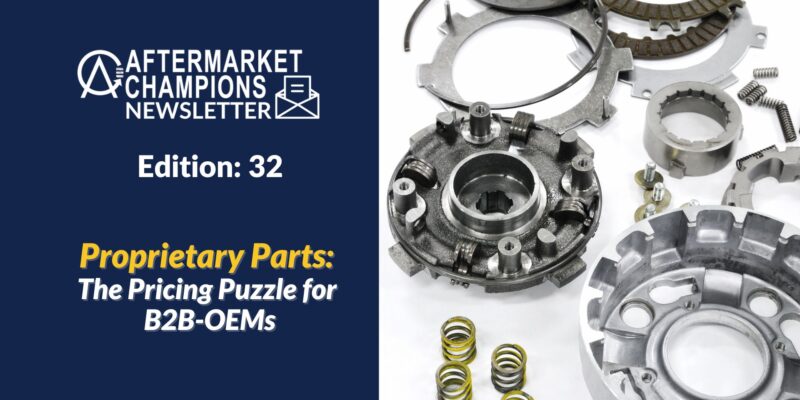
Every operating partner knows the feeling. You’re sitting in a quarterly portfolio review, looking at yet another OEM that’s underperforming on aftermarket revenue again. The management team acknowledges the opportunity. They’ve even invested in “digital transformation” initiatives. But somehow, the aftermarket remains a black box. Parts sales plateau. Service contracts expire unnoticed. The installed base sits there, generating far less than it should.
For private equity firms focused on PE value creation strategies in 2025, this isn’t just frustrating, it’s expensive. Every quarter of missed aftermarket revenue is delayed by EBITDA growth. Every year that passes without unlocking this channel pushes exit multiples lower and extends hold periods. PE-backed OEMs understand conceptually that their aftermarket is profitable, but they fundamentally cannot unlock it. The culprits? Legacy ERPs that were never designed for aftermarket visibility, siloed CRMs with incomplete customer data, and multi-year digital projects that consume budgets but deliver minimal ROI.
This is the portfolio EBITDA growth challenge that defines industrial portfolios today: the aftermarket opportunity is visible, quantifiable, and theoretically straightforward—yet systematically inaccessible.
The Blind Spot: The Prize Left Untapped
The economics are undeniable. Industry research from McKinsey and BCG consistently shows that aftermarket services and parts can represent up to 70% of OEM profitability, despite generating only 20-30% of total revenue. These are the highest-margin dollars in industrial businesses. Yet across private equity portfolios, millions in aftermarket revenue growth in OEM portfolios sit untapped simply because firms lack visibility into what they own.
Consider the packaging industry, a sector where many PE firms have concentrated exposure. The global packaging equipment market continues its steady expansion, driven by e-commerce growth, food safety regulations, and automation trends. This means the installed base of packaging machinery is growing every year. More machines in the field should translate directly into expanding aftermarket opportunities: replacement parts, preventive maintenance contracts, consumables, retrofits, and upgrades.
But here’s the disconnect: packaging OEM aftermarket opportunity expands proportionally with installed base growth, yet most portfolio companies can’t even tell you with confidence how many machines they have in operation, where those machines are located, what configurations they’re running, or when service contracts are expiring. They’re sitting on an appreciating asset – their installed base- without a reliable inventory of what that asset contains.
This blind spot isn’t unique to packaging. Across material handling equipment, printing machinery, industrial automation, and food processing equipment, the story repeats. The installed base exists. The customers need parts and service. The profitability is proven. But the connection between supply and demand remains fractured because the foundational data layer doesn’t exist.
Why Installed Base Data Has Stayed Locked
The root cause isn’t lack of effort or investment. Most PE-backed OEMs have attempted to solve this problem. They’ve launched digital transformation initiatives, hired CDOs, and invested in data warehouses. In addition, many have purchased CRM licenses and pursued system integrations.
Yet the installed base data remains locked. Why?
First, fragmentation. A typical mid-market OEM acquired by private equity operates across multiple ERPs—sometimes one for each business unit, geography, or legacy acquisition. Customer data lives in Salesforce for one division, Microsoft Dynamics for another, and spreadsheets maintained by regional service managers everywhere else. Serial numbers exist in manufacturing systems. Warranty records sit in separate databases. Contract data resides in yet another system. No single source of truth exists, and creating one requires reconciling decades of inconsistent data entry, duplicate records, and missing information.
Second, lack of standardized reporting prevents portfolio-wide visibility. Even when individual portfolio companies have relatively clean data, PE firms can’t aggregate insights across their holdings. Each OEM uses different metrics, definitions, and reporting cadences. Rolling up aftermarket performance across five or ten portfolio companies becomes an exercise in manual data wrangling rather than strategic analysis.
Third, digital transformation challenges in PE portfolio companies typically stem from scope and timeline. The traditional approach involves 18-24 month implementation projects: requirements gathering, vendor selection, system integration, change management, and gradual rollout. By the time these initiatives deliver value, the hold period is half over. The IRR impact is minimal. Operating partners become skeptical of the next “transformational” technology pitch.
These aftermarket intelligence barriers aren’t technical curiosities—they’re value creation blockers that directly impact fund performance.
Installed Base Intelligence: The Unlock
The breakthrough comes from reframing the problem. Instead of treating installed base visibility as a by-product of broader digital transformation, treat the installed base itself as an asset class—similar to how SaaS businesses track Annual Recurring Revenue.
This is where Installed Base Intelligence changes the equation for private equity value creation strategies.
The concept is straightforward: create a unified, continuously updated view of every asset in your installed base, enriched with intelligence about service history, parts consumption, contract status, and revenue potential. But the execution requires specialized capability—technology purpose-built for this exact problem rather than general-purpose enterprise software retrofitted to aftermarket use cases.
Entytle’s Installed Base Intelligence platform addresses the core challenges that have kept aftermarket revenue locked:
Data unification happens in weeks, not years. Rather than requiring massive integration projects, the platform ingests data from existing ERPs, CRMs, and other source systems, then applies AI-powered matching and cleansing to create a golden record of the installed base. Serial numbers get standardized. Duplicates are resolved. Missing information is inferred from available data patterns.
Intelligence is embedded from day one. The platform doesn’t just organize data—it generates actionable insights. Which machines are approaching service intervals? Which customers have high parts consumption but no active contract? Where are geographic clusters of equipment that could support field service optimization? These insights emerge automatically rather than requiring manual analysis.
Results are measurable within 9-12 weeks. Because the platform is purpose-built for installed base intelligence for PE use cases, implementation timelines compress dramatically. Portfolio companies see fast EBITDA growth strategies deliver tangible results within a single quarter rather than multi-year horizons.
The paradigm shift is treating installed base data as a strategic asset that drives revenue, rather than an operational housekeeping challenge. When you can see what you own, where it’s located, and what it needs, the aftermarket unlocks naturally.
Proof of Impact for Private Equity Firms: What Happens When the Frustration Ends
The theoretical value proposition is compelling, but private equity firms invest based on proven returns. The track record speaks clearly.
One portfolio company—a mid-market packaging OEM—unlocked $4.5 million in aftermarket revenue within 9 weeks of deploying installed base intelligence. The revenue wasn’t hidden in some exotic new service offering. It was sitting in their existing customer base: expired contracts that were never renewed, machines requiring scheduled maintenance that were never booked, and parts orders that were going to aftermarket distributors because the OEM didn’t proactively reach out.
Another portfolio company achieved 22% aftermarket revenue growth year-over-year after implementing systematic installed base visibility. Their sales team finally had reliable data about which customers to contact, when to contact them, and what to offer. Service scheduling became proactive rather than reactive. Parts inventory optimization improved because demand forecasting was based on actual installed base analytics rather than historical guesswork.
The financial returns are equally clear: PE aftermarket revenue case studies consistently show 3.5x ROI in the first year. For a mid-market portfolio company, that might translate to $200K in platform investment generating $700K in incremental EBITDA—EBITDA that compounds year after year throughout the hold period.
But the real alpha comes from portfolio-level scaling. When you prove the model works with one portfolio company, you can deploy across five, eight, or ten OEMs simultaneously. The compounding effect is exponential: each additional portfolio company that unlocks its aftermarket contributes to portfolio-wide EBITDA growth, raising the valuation of the entire fund. This is how EBITDA levers for PE firms create meaningful differentiation in competitive exit markets.
The Private Equity Playbook: From Frustration to EBITDA Expansion
For operating partners and portfolio operations teams ready to move from frustration to execution, the PE operating partner playbook is straightforward:
Step 1: Audit aftermarket contribution to EBITDA across your portfolio. Most OEMs can tell you aftermarket revenue, but margin contribution is often poorly understood. Establish baseline metrics: What percentage of EBITDA comes from the aftermarket today? What’s the parts margin versus service margin? Where does your portfolio sit relative to industry benchmarks?
Step 2: Assess installed base data visibility. Can each portfolio company answer basic questions with confidence? How many units are in the field? Where are they located? What’s our contract penetration rate? Which machines are most likely to generate parts orders in the next 90 days? If these questions require weeks of manual data gathering, you’ve identified the problem.
Step 3: Benchmark aftermarket digital maturity. Evaluate where each portfolio company sits on the maturity curve. Are they running entirely on spreadsheets and institutional knowledge? Do they have systems in place but limited integration? Are they drowning in data with no actionable insights? Understanding the current state informs implementation approaches.
Step 4: Deploy aftermarket intelligence systematically across portfolio companies. Start with one or two OEMs to prove the model, then scale rapidly. The portfolio company value creation strategies that win are those that can be replicated across multiple assets without reinventing the wheel each time.
The operating leverage comes from treating this as a portfolio-wide initiative rather than individual company projects. Shared best practices, common KPIs, and consolidated reporting create portfolio-level intelligence that drives alpha.
Forward-Looking Insight: The Next Alpha Playbook
The private equity landscape is shifting. As operational improvements become more critical than financial engineering to drive returns, the firms that excel will be those that identify and scale repeatable value creation playbooks.
Aftermarket intelligence represents the next frontier of operational alpha strategies for private equity. Over the next five years, we’ll see the distinction between firms that have systematized installed base visibility and those still treating it as a company-specific challenge.
The future of PE value creation will increasingly be defined by data monetization—not in the consumer tech sense, but in the industrial context of turning operational data into revenue-generating insights. OEMs that understand their installed base can move beyond transactional parts sales to predictive service models, equipment-as-a-service offerings, and customer success partnerships that increase lifetime value and stickiness.
Firms that solve the technology and data frustration early will differentiate their portfolios in crowded markets. When two PE-backed packaging OEMs go to market simultaneously, the one with sophisticated installed base intelligence, predictable aftermarket revenue, and demonstrable digital maturity will command higher exit multiples. The aftermarket story becomes a growth story, not just a margin story.
Conclusion: Tools, Not Awareness
Private equity firms don’t lack awareness of the aftermarket’s value. Every operating partner knows the economics. Every portfolio company management team acknowledges the opportunity. The frustration exists because awareness without execution is just expensive knowing.
The constraint has never been recognition—it’s been tooling. Legacy systems weren’t built for installed base intelligence. General-purpose digital transformation takes too long and costs too much. The data remains fragmented, the insights remain elusive, and the EBITDA remains on the table.
Installed Base Intelligence fixes what’s broken. It unifies fragmented data, generates actionable insights, and delivers measurable results on PE-relevant timelines. For firms ready to move from frustration to results, the path is clear.
Ready to unlock hidden EBITDA and deliver predictable aftermarket revenue growth across your portfolio? Book a demo to see how Entytle helps PE-backed OEMs transform their installed base into a measurable value creation engine.




